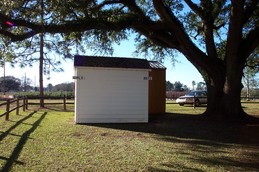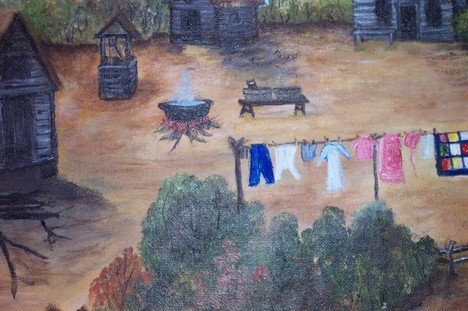|
"The trouble with a new knife is...the great need to use it!
Christmas time brought a new knife to Tom Dodd, Jr. It was a wonderful gift. A boy could do all sorts of great things with a knife. He could whittle, play mumbletypeg, skin a squirrel, clean a fish, and carve. It also brought some business at school with Miss Sadie Littlegreen . You see, when Tom went to the boys outhouse he could not resist taking out his knife and making a carving in the wall. The next day, Miss Sadie called him to her desk and asked, "Tom did you get a new knife for Christmas?" "Yes" and then he bragged, "a Barlow." "Did you carve your initials in the boys outhouse?" she asked. " Miss Sadie had me so I admitted I did. I spent the next several days after school sanding and removing my monogram off the boys outhouse." Tom Dodd, Jr.
0 Comments
WARSHING (Washing) CLOTHES
Build fire in backyard to heat kettle of rain water. Set tubs so smoke won’t blow in eyes. Shave one whole Cake of lye soap in boiling water. Sort things; make 3 piles 1 pile white, 1 pile colored, 1 pile work britches and rags. To make starch, stir flour in cool water to smooth, then thin down with boiling water. Take white things, rub dirty spots on board, scrub hard, and boil, Then rub colored, don't boil just rinse and starch. Take things out of kettle with broom stick handle, then rinse, and starch. Hang old rags on fence. Spread tea towels on grass. Pour rinse water in flower bed. Scrub porch with hot soapy water. Turn tubs upside down. Go put on clean dress, smooth hair with hair combs. Brew cup of tea, Sit and rock a spell and count your blessings. "Use it Up, wear it out, and make it do, or do without."
" Waste not, want not." You saved every scrap of anything to make into other things that were needed. Clothing was made out of feed, flour or sugar sacks. The sacks were made out of colorful cloth that had different patterns from flowers, strips, to plain colors sewed together with very strong string. When the sacks were emptied of food, they were taken apart and washed for the cloth to make shirts, dresses. and other items for the home. You save the string, wrapping it into a ball for safe keeping till it was needed for sewing or other things. Clothing was patched till it could no longer be patched, then the material that was good was cut out and made into quilts. When a quilt wore out on the outside, it was used as batting with a new top made and fastened over the old quilt by tying. These quilts were called "Peek-a-boo" quilts, meaning if you looked inside you would see the old worn out quilt. Our forefathers were very creative smart people that recycled everything they had into other useful items and created and made their own tools. "They had a can do spirit!" My mother would say,"Life is what you make it." When things did not go as planned, my dad would say, "well we will just have to find another way." "OUR YESTERYEARS" Cranford H. Burns, Jesse M. Richardson, Alabama Retired Teachers Association, 1976
"The country one room schoolhouse was not just a place for teaching our children. It was also a community center, where neighbors gather for dances, concerts, lectures, debates, political caucuses and worship.
I truly believe that we can build a well-educated, literate America by drawing on the legacy of courage and resourcefulness left us by our pioneer country school teachers. The restoration of these schoolhouses reminds us of a critical source of our great national strength---a commitment to education for every American. The very real stories that these buildings will tell will inspire us to continue to a proud tradition that will produce more and more stories of hope for our great people." Introduction...America's Country School
Plans are being made by the Alabama 200.Org for the 200th Birthday Celebration of Alabama becoming a state. The territory of Alabama began in 1817 and continued to December 14, 1819 when Alabama became a state of the United States. The celebration is three years long beginning in 2017 to commemorate Alabama becoming a Territory and ending in 2019, our 200th birthday of statehood.
“2017 EXPLORING OUR PLACES “-Alabama has a rich and diverse landscape. From fossil finds to space camp, historic downtown's to beautiful state parks, we will Explore Our Places in 2017.” “2018 HONORING OUR PEOPLE”-Pulitzer Prize-winners, civil rights leaders, athletes, astronauts, master of industry, and innovation and everyone in between. We couldn’t celebrate out history-or make our future-without the folks who have made Alabama home. In 2018 we will Honor Our People.” “2019 SHARING OUR STORIES- By our birthday year, we will have lots to tell about the places we’ve been and the people you’ve met, we Share Our Stories.” [email protected] Spread the word about our state’s 200th birthday. See additional info on Facebook: 200 Alabama Bicentennial; and watch for announcements of events by the state. The celebration is to begin in Mobile May, 2017. Semmes Heritage Park will be participating in the Bicentennial Celebration with our Heritage Day Celebration May 6th. In the process of preserving Semmes History, we are still collecting photos, family stories, and memories of early life in Semmes. Do you have a photo, or a story to share? Did your family homestead in Semmes? In this age of family genealogy you may have discovered your family history related to Semmes that you would like to add to our archives. The book, “Scrapbook of Memories” was the first book published by Semmes Heritage to preserve our history and to provide funds for the restoration of the 1902 Semmes School. It is a collection of photos and memories of early life in Semmes. Plans are underway for a second addition of “Scrapbook of Memories.” Semmes Heritage Park, the guardian of Semmes History. We are remembering the Past as we look to the future. Don’t forget, we are an all volunteer group and new members are welcome. Information 1-251-649-0270 - Semmes Heritage, P.O. Box 2152, Semmes, Alabama 36575 |
SemmesPreserving our History Archives
November 2023
|



 RSS Feed
RSS Feed